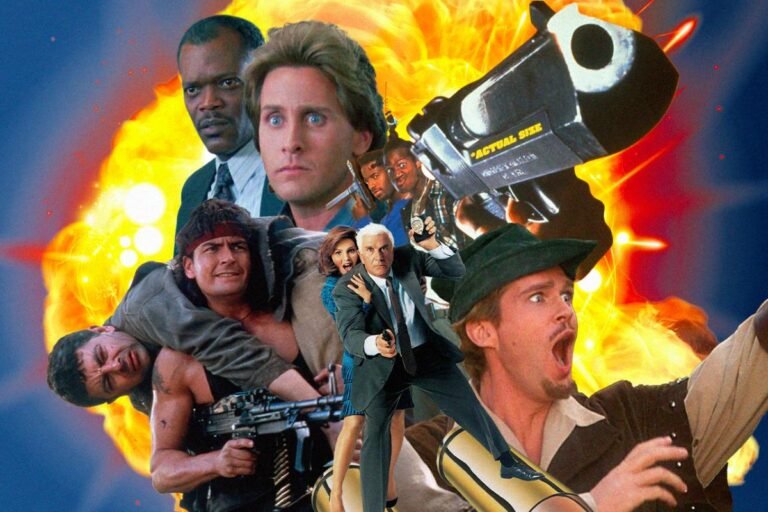The last time a Naked Gun movie hit theaters, we were in a completely different era. The first two movies in the series more or less bracketed the George H.W. Bush era, with the first one released just after his election and the 1991 sequel arriving towards the end of his single term (and sending him off with several slapstick smacks to poor Barbara Bush’s face); the third and final film came out just past a year into the Clinton presidency. (Another three months after that, co-star O.J. Simpson was in his Ford Bronco chase, leaving fans to wonder what zany mess Nordberg had gotten himself into now.) The new version with Liam Neeson is at least as good as the sequels, maybe as good as the original, and has been held up as a possible savior of theatrically released comedies, which have been few and far between in recent years. The original trilogy, on the other hand, arrived at a time when comedies had a regular presence in the yearly top ten grossers – there were three others alongside the first Naked Gun in 1988. As such, the ZAZ-affiliated movies were able to kick-start a more specific comedy trend, ushering in the Spoof ’90s.
Depending on the broadness of your definition, spoof movies have existed for much of cinema’s history. But the 10-jokes-per-minute style of the Naked Gun movies, seeded in the anarchy of Mel Brooks, was crystalized by Airplane!, whose creators David Zucker, Jim Abrahams, and Jerry Zucker (ZAZ for short) went on to create Police Squad! and the more successful film series. Airplane! inspired a number of 1980s imitators; The Naked Gun opened up the floodgates. The same summer as The Naked Gun 2 ½, Jim Abrahams directed his own spoof picture with Hot Shots!, and it did nearly as well as its companion film. Two years later, there were four different spoof movies in theaters: a Hot Shots! sequel, the return of Mel Brooks with Robin Hood: Men in Tights, plus Fatal Instinct and National Lampoon’s Loaded Weapon 1. After the third Naked Gun in 1994, Leslie Nielsen kept at it, with titles like Spy Hard, Wrongfully Accused, and Dracula: Dead and Loving It (another Brooks project). Abrahams made Jane Austen’s Mafia! And the Wayans Brothers became successful upstarts with Don’t Be a Menace to Society While Drinking Your Juice in the Hood, which led to their work in the defining 2000s-era spoof Scary Movie.

There may have actually been even more spoof movies in the 2000s (Scary Movie alone contributed four entries) but with the exceptions of a couple strong one-offs, they felt more cookie-cutter, right down to the titling and the “from two of the six writers of Scary Movie” poster gag. (Considering those two writers were responsible for Date Movie and Epic Movie, it quickly became more warning than cute joke.) In the ’90s, spoof business was so booming that multiple filmmakers though that they could hire Leslie Nielsen and make their own Naked Gun.
It’s a little strange, then, that hardly any of those ’90s titles belong on a list of the genre’s best. The strongest ZAZ projects came out in the 1980s; the Naked Gun sequels and, to a lesser extent, Hot Shots! are fun enough, sometimes downright hilarious, but they’re not top tier. Nor is Robin Hood: Men in Tights, a good-enough Brooks attempt to get back in the spoof game well after his 1970s peak. The best the Nielsen projects can hope for is genially amusing; Wrongfully Accused is written and directed by ZAZ-affiliated gag man Pat Proft, so it has some solidly silly parody work, but it’s also very much an off-brand Naked Gun, right down to the fake hard-boiled narration. Perhaps the most underrated is Fatal Instinct, where Carl Reiner (who made the innovative 1982 spoof experiment Dead Men Don’t Wear Plaid with Steve Martin) tried to keep pace with his pal Mel Brooks, goofing on both old film noir and its then-contemporary erotic-thriller equivalents. It’s not great, but it’s focused without being exceedingly narrow, which is where Hot Shots! and its beat-for-beat parody of Top Gun winds up (yet somehow avoiding goofing on the homoeroticism of that movie’s beach volleyball scene!).

Maybe the movie spoofs of this era look a little musty because half-hour sitcoms of the era were becoming increasingly adept at it – or at least, Seinfeld and The Simpsons were. In some ways, The Simpsons in the ’90s would perfect the spoof formula in ways no one would have thought possible; it has episodes that are sustained riffs on Cape Fear, Citizen Kane, and Thelma & Louise while, like the ZAZ parodies, adding in a densely packed selection of unrelated jokes. On top of that it, they involve characters already established by the show that can (at least sometimes) be deepened and enhanced by the spoofy plots at hand. Spoofs would eventually become more fragmented with YouTube and then TikTok hewing closer to the awful 2000s-era parodies than the well-built vehicles that the new Naked Gun evokes. Maybe that’s what the ’90s spoof proliferation wound up doing: convincing a whole lot of people that comedy was as easy as it looked.
Jesse Hassenger (@rockmarooned) is a writer living in Brooklyn. He’s a regular contributor to The A.V. Club, Polygon, and The Week, among others. He podcasts at www.sportsalcohol.com, too.




